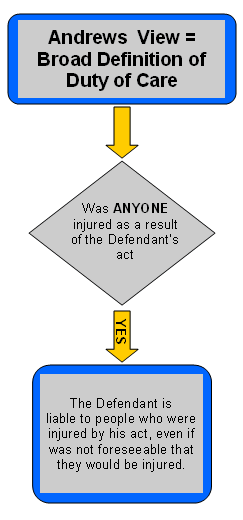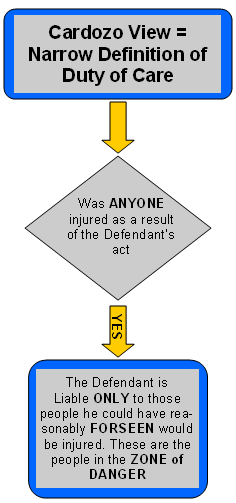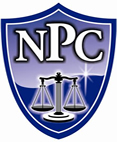re Part 2
Terms:
Zone of Danger Doctrine:
The doctrine allowing recovery of damages for people who were located in the dangerous area caused by the defendant’s negligence and who suffered harm as a result of the defendant’s negligence. |
Once it is established that there is a duty owed, we must determine to whom the duty is owed.
The general rule is that if a reasonable person would not have foreseen injury to anyone through his conduct, there is no duty owed to anyone who was unexpectedly hurt by the defendant’s actions.
However, there is a split in the authority as to the question of foreseeable danger (harm that the defendant could have reasonably predicted).
 For unforeseeable plaintiffs, the broad view is that the defendant owes the duty of care to anyone who is injured as a proximate result of his actions. In other words, where the plaintiff is injured by the defendant’s actions, the defendant is liable regardless of whether a reasonable person would have foreseen a risk of harm to the plaintiff. As long as the defendant’s actions were the proximate cause of the plaintiff’s injuries, the defendant will be held liable. This is called the Andrew’s view. For unforeseeable plaintiffs, the broad view is that the defendant owes the duty of care to anyone who is injured as a proximate result of his actions. In other words, where the plaintiff is injured by the defendant’s actions, the defendant is liable regardless of whether a reasonable person would have foreseen a risk of harm to the plaintiff. As long as the defendant’s actions were the proximate cause of the plaintiff’s injuries, the defendant will be held liable. This is called the Andrew’s view.
For the sake of analysis, under the Andrews view, you first look at the harm that the plaintiff suffered. Then, if you can work backwards and link the harm to the defendant’s actions you can assign liability to the defendant.
 The narrower view is called the Zone of Danger Doctrine, or the Cardozo view. In the Cardozo view, the defendant owes the duty of care only to those people who are within the zone of danger (the dangerous area) created by the defendant’s negligent behavior and who suffer foreseeable harm as a result of the defendant’s actions. That is to say, the court will look at the defendant’s actions and determine both the zone of danger created by the actions and the likely harm people in the zone of danger could suffer. Any plaintiff who is both in the zone of danger and who suffers the type of harm that is a foreseeable result of the defendant’s actions will be able to recover. The narrower view is called the Zone of Danger Doctrine, or the Cardozo view. In the Cardozo view, the defendant owes the duty of care only to those people who are within the zone of danger (the dangerous area) created by the defendant’s negligent behavior and who suffer foreseeable harm as a result of the defendant’s actions. That is to say, the court will look at the defendant’s actions and determine both the zone of danger created by the actions and the likely harm people in the zone of danger could suffer. Any plaintiff who is both in the zone of danger and who suffers the type of harm that is a foreseeable result of the defendant’s actions will be able to recover.
The Andrews and Cardozo views both arise from Palsgraff v. Long Island Railroad, 248 N.Y. 339 (1928), one of the most important cases in all of tort law. What happened in Palsgraff is this:
Two men were running to catch a train. One of them was holding a package in his hand. One of the railroad employees was running along with the two men to help them board the moving train. As the employee was helping the man with the package board the train, the package fell from his hands. The package, which contained fireworks, exploded upon hitting the ground. The train’s platform was crowded with people and, upon hearing the explosion, the people on the platform began to rush out of the train station. In doing so, some heavy scales meant for weighing baggage were knocked over and Mrs. Palsgraff was hit by one of these scales. She was standing about thirty feet away from the exploding package.
The question that the jury needed to answer was whether or not the railroad employee was liable for Mrs. Palsgraff’s injuries. Under the Cardozo view, Mrs. Palsgraff would not be able to recover. Remember the Cardozo view states that defendant owes a duty of care only to those persons to whom a reasonable person would have foreseen a risk.If a package with fire crackers fell on the ground, it would be reasonable to foresee that people within two or three feet of the package might be hurt. Therefore, the zone of danger created by the defendant's negligence in this case would be two or three feet from where the package exploded. But, according to Justice Cardozo, it was unforeseeable that a woman standing thirty feet away would be hurt by falling scales caused by the panic of the people standing on the train platform. According to Justice Cardozo, Mrs. Palsgraff was standing outside the “zone of danger” and thus, was not a foreseeable plaintiff.
According to Justice Andrews, Mrs. Palsgraff would be able to recover because any plaintiff that suffers injury as a proximate result of defendant’s actions can recover. That is to say, Justice Andrews would have looked at Mrs. Palsgraff’s injuries and looked at the events leading to the injuries in reverse sequence to find the causal link. He would have seen the injuries and linked them to the falling scales which were linked to the rushing crowd, which was linked to the exploding package which was linked to the railroad employees’ negligence. Thus, according to Justice Andrews, Mrs. Palsgraff could recover.
In short, the difference between the Cardozo view and the Andrews view is one of foresight vs. hindsight. Justice Cardozo takes the position that if, in foresight, you can reasonably foresee a risk to a plaintiff, that plaintiff can recover. According to Justice Andrews, if in hindsight you can link the plaintiff’s injury to the act of negligence, then plaintiff can recover.
———————————————————————————————————————————————
The general rule also states that if a defendant owes a duty to anyone, he also owes that duty to anybody who goes to the rescue of a harmed plaintiff. Under the theory that “danger invites rescue”, any rescuer that enters the zone of danger in order to rescue a plaintiff is owed the same duty as the plaintiff. See Wagner v. International Railway 232 N.Y. 176 (1928). The rationale is that a rescuer is as much a foreseeable plaintiff as the original plaintiff himself, and is therefore within the scope of the defendant’s duty. Furthermore,the defendant will be held liable for any injuries that the rescuer causes to the original plaintiff. For Example:
Shag negligently pushes Kobe and Kobe falls into a river. Phil jumps into the river in order to save Kobe but, while doing so, Phil accidentally breaks Kobe's arm. Shag will be held liable both for pushing Kobe into the river and for any harm that Phil suffers trying to rescue Kobe. Further, Shag will be held liable for the broken arm that Phil caused Kobe. (Shag will be held liable for any injuries Phil suffers while trying to save Kobe.)
However,the defendant will not be held liable for harm that a rescuer causes if the rescue attempt was unreasonable. For instance, in our previous example:
If Phil had tried to rescue Kobe from the river by extending a live electrical wire for Kobe to hold onto, and Kobe suffered electrical burns, Shag would not be held liable for those burns because Phil’s rescue attempt would have been unreasonable.
Where professional rescuers come to the aid of a plaintiff, it is generally held that the defendant is not liablefor harm suffered by the rescuers. See Maltman v. Saur 530 P.2d 254 (Wash. 1975). For example:
Shag negligently sets a fire. The local fire department answers the call and comes to put out the fire. While rescuing Kobe from the fire, one of the firemen suffers a broken leg. Shag will not be held liable for the fireman’s injuries.
The rationale here is that it is the rescuers job to rescue a plaintiff and we do not want to discourage defendants from calling in professional help to remedy their negligent actions for fear of being held liable.
———————————————————————————————————————————————
There are situations where a defendant is held liable for harm caused to the plaintiff by a third party. There are basically three things to remember here:
(1) Those who control, or have in their possession dangerous substances, owe a duty to exercise care to prevent foreseeable harm to others. For Example:
Shag, a fireworks dealer, sells fireworks to a group of 10 year old children. The children set off the fireworks causing severe injury to Kobe. Because fireworks can be considered a dangerous object, Shag owes a duty not only to the children to whom he sold the fireworks, but to others as well since it is foreseeable that young children might misuse the fireworks and injure someone.
See Jones v. Robbins 289 So. 2d 104 (La. 1974).
(2) The defendant has a duty to not create an unreasonable risk of harm from third parties. In other words,the defendant has a duty to not encourage a third party to commit unreasonable acts. See Weirum v. RKO General, Inc. 15 Cal.3d 40 (1975). For example:
Pizza Palace advertises that if you order a pizza and the pizza is not delivered within 30 minutes, you get the pizza for free. As a result, Pizza Palace’s delivery drivers drive recklessly so as to make sure they deliver their pizzas on time. In the event that a plaintiff is injured by a Pizza Palace driver, the company could be held liable for the damage to the plaintiff because they had encouraged the unreasonable risk of harm.
(3) If the defendant has a special relationship with the plaintiff or the third party, the defendant may have a duty to warn the plaintiff of possible harm from another. For Example:
If a psychiatrist has reason to know that his patient is likely to harm a specific third party, the doctor owes a duty to warn the victim or law enforcement of the possibility of danger. The doctor’s duty arises from thespecial relationship he has with the Defendant.
See Tarasoff v. Regents of the University of Cal 17 Cal.3d 425 (1976).
|
©2003 - 2013 National Paralegal College


